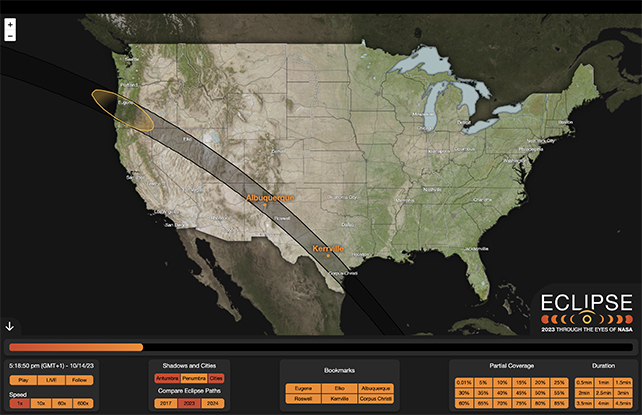If you're keen to see this week's 'ring of fire' eclipse – and quite honestly, who wouldn't be – NASA has published a new online map that lets you track the path of the cosmic phenomenon in real time across North, Central, and South America.
The map, which is called the NASA 2023 Eclipse Explorer, is fully interactive, allowing you to zoom in and out and flick through layers to follow the path of the eclipse as viewed from the ground.
These eclipses happen every year or two, but not everyone gets to see them: this is the first eclipse of this type that can be seen in the US since 2012, and will be the last one until 2046 rolls around.

Technically, they're known as annular eclipses, which means 'ring shaped'. They happen when the Moon is the farthest away from the Sun on its elliptical orbit, causing it to appear smaller than the Sun from Earth. When this slightly smaller-looking Moon passes in front of the Sun, a glimmer of the star's corona appears as a circle – or the annulus – around the Moon's edge.
If you want to get technical, you might want to trace the path of annularity – that's the spot on the Earth where the annular solar eclipse can be seen from. As all three celestial bodies move through space, so does this location on Earth.
Which brings us back to the new NASA 2023 Eclipse Explorer. If you've got patience you can follow the path of annularity in real time. If not, crank the speed up and make it 600 times faster. Using the buttons underneath the map, you can also view areas of partial coverage, and where the eclipse is going to last the longest.
It's a comprehensive resource if you're planning to get out and do some eclipse-spotting, but it's not the only one available. You might also want to check out the Eclipse Simulator, which will show you how the annular eclipse will actually look.
There's also the Great American Eclipse website, which offers some impressive flyover videos that give you a great idea of how the path of annularity is going to progress as the day progresses on October 14.
An eclipse of any description always results in some stunning photos – whether it's the total lunar eclipse of May 2021, the total solar eclipse of December 2021, or any other similar event. Let's hope this week's eclipse is the same.
A word of warning if you are planning to gaze upwards on Saturday, October 14 when the annular eclipse will be visible in the United States: make sure you're wearing glasses specifically certified to offer protection for solar eclipses.
